Robyn Ryle's Blog, page 3
January 19, 2018
Go away so I can think, already
Depending on how you count it, it’s week two of my sabbatical and I’m currently sitting in my writing chair, trying to fend off the cat who feels she is much more worthy of my lap than this computer. Some days, I think she’s probably right.
During the first week of my sabbatical, many of the days I was supposed to have alone in the house didn’t turn out that way. My husband and/or daughter were right here with me due to snow days and e-learning days and every possible excuse you can imagine not to go to work or school. This was a tiny bit disappointing.
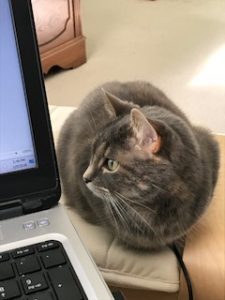
Um, hello? That lap belongs to me.
It’s not that I don’t love my husband and my daughter (and even the annoying cat). Hours after they leave the house, I miss them pretty, which is good. Missing people is good. You can’t miss people when they’re with you all the time. Really. I’ve tried, but it’s very difficult to miss someone when they’re in the next room.
I certainly do a lot of writing with everyone in the house. I do a lot of writing in a coffee shop, with people who talk loudly and listen to youtube videos with the volume turned all the way up (what is that about?). There was a period in my writing life where I yearned for the proverbial “room of my own.” I aspired at times to an entire house of my own, like George R.R. Martin, who owns a house right across the street from his own home and goes there every day to write. Though, on second thought, that doesn’t seem to be working out so well for him.
I’ve applied to writing retreats in the past with no success. Eventually, I stopped trying. Not because I was hopeless, but I began to wonder whether I really wanted to be away from my family and my house and my town for that long? Maybe the annoying cat is actually integral to my writing?
Here’s what I do know—I’m likely to do a different sort of writing when I have long stretches of time alone. That’s because I do a different sort of thinking. It’s just me and the cats and my thoughts and nowhere else for them to go. This is both amazing and terrifying. Perhaps all things that are amazing are also terrifying.
If you can get past the loneliness, or the mean reds, that paralyzing, deep-body fear that there’s really no point. If you can stare into that abyss and come out the other side, there’s something so satisfying about being alone with the quiet and your thoughts. Given the way we’ve attached ourselves to our phones, being alone with your thoughts might be the most radical thing you can do in today’s world.
I have a lot of practice at being alone and thinking, thankfully. I had siblings and friends to play with when I was little, but what I craved most of all was to be able to play by myself. I wanted to go out in the woods and disappear into a different world, one all of my own making. Or sit in my room and stare out the window and imagine. That’s still what I’m doing a lot of the time when I’m alone, even as a grown-up.
When I’m really alone in the house, I can’t walk downstairs and tell my husband all about this weird train of thought I just had, like why don’t you meet more people with Russian surnames in the U.S.? Are there that few Russian immigrants or did they all just Anglicize their names? And if so, why? What is it about being Russian that makes you want to ditch your last name?
Anyway, I can’t go ask my husband questions like that when I’m alone. I can’t distract myself by seeing what my daughter’s up to. I have to wait for someone to get home and sometimes that’s too long. So I start writing instead. Those thoughts get transformed from conversations into written words.
I wish I could say that this isn’t just about being alone and that there’s a way to re-create that feeling even when I’m not alone. Certainly, sometimes conversations also get turned into written words. But there’s a space that opens up when you have time alone. More things seem interesting. More paths appear worthy of a good linger. The ticking of the clock slows down a bit. There’s a wonder in it, the magic place where so many good stories begin.
P.S. Hey, also, have I mentioned I have a real, live book coming out in March of 2019? I know that seems really far away, but books take a long time to make. Much longer than you think. Stay tuned for updates, though.
January 15, 2018
Madison Monday: MLK Day Reprise
 In honor of Martin Luther King, Jr. Day, a re-post of one of my very first Madison Monday’s. I love this book and I love this story for the way it demonstrates how our racial reality becomes taken-for-granted as natural and given, even though it always has a very distinct history. There is nothing “natural” about the fact that there aren’t a lot of black people in Madison. There is nothing “natural” about race at all.
In honor of Martin Luther King, Jr. Day, a re-post of one of my very first Madison Monday’s. I love this book and I love this story for the way it demonstrates how our racial reality becomes taken-for-granted as natural and given, even though it always has a very distinct history. There is nothing “natural” about the fact that there aren’t a lot of black people in Madison. There is nothing “natural” about race at all.
In honor of Dr. Martin Luther King, Jr., I thought I would review a wonderful book about the black community right here in Madison, Indiana. I’ve often thought it would be good for someone to write a basic book that explains for the kind of “average” white person how race matters in their lives. White folks still don’t really have to think about our race as often as people who aren’t white do, but this doesn’t mean that race doesn’t matter. It’s just that the ways in which race matters are often hidden or just not as apparent as it might be. For example, I grew up in a small town like Madison that was mostly white. In my small town, there were really only two black families, and this seemed to be the way it always was and the way it always had been. After reading All We Had Was Each Other, I’m not so sure.
Most people in the United States grow up in segregated communities, and so if you’re white, you probably grew up mostly around other white people. This can seem like just “the way things are.” Natural. The black people live over there and we live over here. For me and a lot of folks from small towns, the black people all lived in the city (Cincinnati) and the white folks all lived out in the small towns and country. But there is nothing natural at all about racial segregation. It is deeply institutionalized in our nation with practices like redlining (where first Federal Housing Authority officials and then eventually banks and real estate agents designated areas where minorities lived as being “high risk” and therefore lower in property value) and racial steering (as a white person, have you ever gone looking for a home and been taken into a neighborhood that was not majority white? Have you ever tried to get a real estate agent to take you as a white person to a neighborhood that wasn’t majority white? Real estate agents legally aren’t supposed to talk about race, but that doesn’t mean it’s not a part of standard operating procedure). These say nothing of the more blatant practices of restrictive covenants (which often prohibited homeowners in a neighborhood from ever selling to someone who wasn’t white) and, say, burning crosses in people’s yards to discourage any more of “their” kind from moving in.
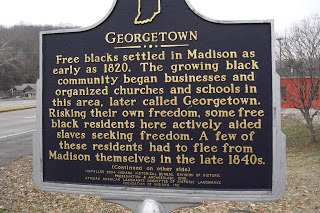 In All We Had Was Each Other, you learn about how the town of Madison, Indiana became 93% white and 3% African-American. Don Wallis, a white man who grew up in Madison himself during the time period he focuses on, collected oral histories of black residents from Madison, many of them no longer living in the town. As Wallis says in his preface, in the Madison he grew up in during the 1950s and 1960s, black people could only live in one section of town. They could work only as handymen, cooks, and maids for white people. Black children attended an all-black school and black people went to all black churches. The hospital had two rooms set aside in the basement for black residents, and if they were filled, tough luck. Black people could not eat in restaurants and had to sit in the balcony at the movie theater. They had to address white residents as “Mr.” or “Mrs.” and they always knocked at the back door. The beautiful WPA era public swimming pool still in operation here, Crystal Beach, was off limits to them. In essence, Jim Crow was in full effect in Southern Indiana.
In All We Had Was Each Other, you learn about how the town of Madison, Indiana became 93% white and 3% African-American. Don Wallis, a white man who grew up in Madison himself during the time period he focuses on, collected oral histories of black residents from Madison, many of them no longer living in the town. As Wallis says in his preface, in the Madison he grew up in during the 1950s and 1960s, black people could only live in one section of town. They could work only as handymen, cooks, and maids for white people. Black children attended an all-black school and black people went to all black churches. The hospital had two rooms set aside in the basement for black residents, and if they were filled, tough luck. Black people could not eat in restaurants and had to sit in the balcony at the movie theater. They had to address white residents as “Mr.” or “Mrs.” and they always knocked at the back door. The beautiful WPA era public swimming pool still in operation here, Crystal Beach, was off limits to them. In essence, Jim Crow was in full effect in Southern Indiana.
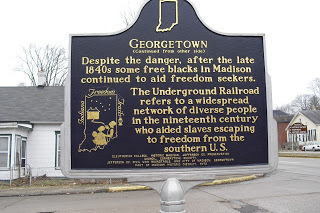 So if you believe that somehow everyone north of the Ohio River is racially innocent, I encourage you to check out this book. That Madison lived under Jim Crow was not completely surprising to me. What was most shocking about these accounts is that the teeny, tiny little area of downtown Madison was completely segregated into two completely different towns and two completely different communities. Downtown Madison is crammed into an area of river valley that is a little over a mile in length and probably less than a mile across at its widest. It is a relatively small, physical space. But when the folks in All We Has Was Each Other were growing up, there was Madison, and there was Georgetown. Pat Cosby, who was born in 1946 in Madison, said, “I remember the boundaries of the Black community. As a kid I knew exactly where I could go and where I could not go. I knew better than to ever go beyond those boundaries….And never, never go past Third Street. That’s where the white neighborhoods were, and I knew I’d get a whipping if I went up there. All the kids in our community knew this.” What comes across in these oral histories is that folks really thought of the space as divided into two towns; Georgetown was where the black folks lived and Madison, or uptown, was where the whites lived. As a sociologist, it’s an amazing example of how space can become so powerfully socially constructed, and a very small space at that.
So if you believe that somehow everyone north of the Ohio River is racially innocent, I encourage you to check out this book. That Madison lived under Jim Crow was not completely surprising to me. What was most shocking about these accounts is that the teeny, tiny little area of downtown Madison was completely segregated into two completely different towns and two completely different communities. Downtown Madison is crammed into an area of river valley that is a little over a mile in length and probably less than a mile across at its widest. It is a relatively small, physical space. But when the folks in All We Has Was Each Other were growing up, there was Madison, and there was Georgetown. Pat Cosby, who was born in 1946 in Madison, said, “I remember the boundaries of the Black community. As a kid I knew exactly where I could go and where I could not go. I knew better than to ever go beyond those boundaries….And never, never go past Third Street. That’s where the white neighborhoods were, and I knew I’d get a whipping if I went up there. All the kids in our community knew this.” What comes across in these oral histories is that folks really thought of the space as divided into two towns; Georgetown was where the black folks lived and Madison, or uptown, was where the whites lived. As a sociologist, it’s an amazing example of how space can become so powerfully socially constructed, and a very small space at that.

Roger’s Corner used to have a separate entrance for African-Americans
Many of the people Wallis interviewed are successful doctors, lawyers and teachers, but not so many of them live in Madison anymore. And this is how Madison mysteriously became so very white. When this generation of black residents went away to colleges and universities and came back with educations, they found no one in Madison or the surrounding areas was willing to hire them to do anything but mow their lawns or cook their meals. And so they left and went places that would allow them to better themselves. How many other places in the Midwest have this same story? If you’re living in a small town that’s almost all white, you might ask yourself, was the place I’m living in created by the unwillingness of those in power to allow other people to have the same things they do? Is that why there are no black people here? I’m guessing a lot of times, the answer is probably, yes.
But if they have to come back, it means that a whole host of talented and intelligent folks are no longer in our town. The Broadway School is gone. Much of the Georgetown neighborhood was destroyed when the hospital in Madison expanded. When folks talk about “historic” Madison, the stories of the people in this book don’t often seem to be the history they’re most interested in. But if you’re interested in a different history, All We Had Was Each Other has a lot to teach us here in Madison and in other communities across the country about a past that isn’t so far away and the segregated reality that we live with today.All We Had Was Each Other is not a book about how horrible it was to grow up in Madison as a black person. A lot of what the folks Wallis interviewed had to say focuses on the strength and resilience of the black community in Madison. They talk about important teachers at the all black Broadway School, like Anna O’Banion, George Guess, Daisy Bishop and the Bentley sisters and how those teachers inspired them to pursue a college education. Frank Inskeep discussed organizing the first NAACP chapter in Madison. They discuss how close, connected and supportive the black community in Madison was. And many of them who have left discuss the pleasure of coming back to visit Madison and bringing their children and grandchildren with them.
January 8, 2018
Madison Monday: the cool people
Does this happen everywhere or is it just a small town thing? You see someone around over and over again and you think to yourself, they seem kind of cool. Why don’t I know them? Like, really, why don’t I know them? There are only about 15,000 people in the whole town and fewer than that who live downtown, which is where I see them over and over again. It’s not hard to know people in a place like this. Why don’t I know them? And then, of course, the inevitable question for me—is it something about me? Am I not cool enough to know these people?
Maybe it’s a small-town phenomenon. Certainly, in small towns people stick out more easily. You notice the woman who dresses like she lives in Paris and rides her bike around town everywhere. You can catalog every single person who seems the least bit “out of place.” There might be fewer of them than there would be in a city, but per capita, you get your fair share of oddballs. Enough that you start to wonder if “out of place” is even the right expression. Maybe weird people fit right in.
How do people find each other? As a sociologist, I find questions like these fascinating. Clearly a lot of people know each other from their jobs. There’s a whole network of people who work at the college and know each other that way. But with a town this small, you can convince yourself that you really should intersect at least in some way with all the networks that are out there. Small communities are supposed to be all about homogeneity, right? Everyone is like everyone else.
Only, it’s not at all true. There was a restaurant downtown a few years back. It was my family’s favorite restaurant. It was the favorite restaurant of all my friends and a lot of the people who work at the college. When I went to this restaurant, it seemed like everyone I knew was there at one point or another. There were also some people I didn’t know, but eventually, they became my friends, too. It was that kind of place—a place that brings people together.
Then one day I was talking to a friend who lives out in the country. Her children went to a different high school and she was friends with some of those people. They live in the next town over, sure, but not that far away. These people had NEVER EVEN HEARD OF THIS RESTAURANT! Like, didn’t even know it existed. They lived less than 15 miles away and they may as well have been from another planet. Everyone is like everyone else, my ass!
I grew up in a town where everyone pretty much knew everyone else. As the place suburbanized, the influx of people out-paced that assumption. But I was on the tail edge of that turnover. We still knew most of the newcomers and we sure as hell still knew all the people who’d been born and raised there.
Now I’m a newcomer and I know that’s reflected in my own networks. Most of the people I know are not from Madison. That’s how it goes. If you grow up in a place, you arrive in adulthood with a full dance card of friends. It might be hard to find the motivation to add new ones. And as the long-time folks in the town where I grew up pointed out, newcomers are already more mobile. You might be less likely to invest your time in them because you assume they’re eventually going to leave.
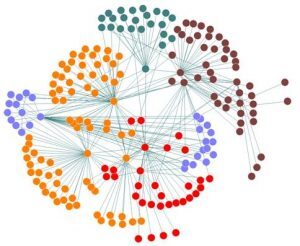
Map of a social network
Sociologists who study community also talk about how open different places are. Is it easy to jump into what’s going on in a new community and get involved? Is it easy to make friends and join a bowling league, if that’s your thing? Madison has always seemed pretty accessible to me. There’s a sort of excitement when new people show up. Who’s that? What might they bring to the table? From my admittedly white, middle class, straight and cisgender perspective, it’s always seemed fairly easy to connect with people. No doubt, it’s probably harder depending on the list of identities you bring to the table.
But, no, even in a small town like this, everyone is not like everyone else. People lead parallel lives and sometimes they don’t intersect at all. I find this comforting. The world will try to tell you that small towns are boring, but I don’t think so. There’s a depth there if you have the time to look closely enough. The town looks at first like a boring bucket of muddy creek water. But with a microscope, it comes alive. There’s so much to see. Who is that person and what’s their story? And why don’t I know them?
December 11, 2017
My Totally Random and Non-Definitive Best of 2017 List
Best Resolution from 2016 I Followed Through On
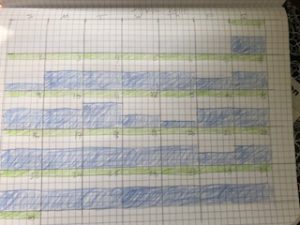 In December of 2016, as the world was just beginning its descent into the chaos and horror that would be 2017, I decided now was the time to start meditating every day. For real. None of this, okay, I’ll do it for a few days and then stop. None of this, missing one day doesn’t really matter. I was going to commit to meditating and for me that meant making spreadsheets. And color-coding graph paper. Which I did, because at this stage of my life, I know what it takes to motivate me to change my behavior. It is spreadsheets and colored pencils.
In December of 2016, as the world was just beginning its descent into the chaos and horror that would be 2017, I decided now was the time to start meditating every day. For real. None of this, okay, I’ll do it for a few days and then stop. None of this, missing one day doesn’t really matter. I was going to commit to meditating and for me that meant making spreadsheets. And color-coding graph paper. Which I did, because at this stage of my life, I know what it takes to motivate me to change my behavior. It is spreadsheets and colored pencils.
The year isn’t over yet, but so far I’ve meditated a total of 354 out of 365 days. I know because of the spreadsheets, you see. I’m considering that a success on many levels. Meditating every day makes my thoughts pleasantly slippery. That really bad class I would’ve obsessed over for the next week? Good-bye! That shitty voice in my head whispering that I’m a horrible person? See ya! Meditation gives me the super-power to tell that voice to shut the fuck up and go away. In fact, meditation makes it almost possible to replace that voice with this super-peppy version of myself who shouts things like, “You rock! Everyone loves you! You’re a trooper!” This is a voice I have never had in my head before, so I am turning the volume way, way up.
Best New-to-Me Music I Listened To
Josh Ritter (thank you, Dave Tegeder). Courtney Barrett (also Dave Tegeder). Langhorne Slim (thank you, River Roots Music Festival). Hiss Golden Messenger and HoneyHoney (thank you, Jane Vonderheide). Ryan Adams (I came for the cat pictures on Instagram and his cover of 1989, I stayed for Prisoner). Lily Hiatt (no idea how I found her). St. Vincent (thanks, Jenny Irons).
Best Music-to-Survive the Apocalypse We Are Currently Living Through
Jason Isbell and the 400 Unit, of course. How many times this year have I listened to The Nashville Sound and cried? I cannot tell you. Then I get to the last song, Something to Love and I feel a little bit more okay. Something to love. Yes, I have that. Good.
Also, Possessed by Paul James and his album, There Will Be Nights When I’m Lonely. Yes, indeed, there will.
Another Good Resolution I Made
The spreadsheet included a cell for daily writing in 20-minute blocks. So I did a lot of writing this year. And even on the days when I didn’t want to, I set a timer and tried to do something for at least 20 minutes. If I could do that, I could usually do more.
Best Young Adult Book I Read
Oh, this is so hard, because there were so many good ones. Strange the Dreamer, by Laini Taylor. But also, Alan Cole is Not a Coward, by Eric Bell (technically this is middle grade, but just an amazing book). Of course, of course, The Hate You Give, by Angie Thomas. I hope this book will be showing up soon as required reading in high school classes across the country. And just here at the end of the year, When Dimple Met Rishi, which was just word-by-word perfect. Like, do you ever want a book where nothing really bad happens? And especially because you love the characters so much, you think your heart will break if something too bad happens to them? And even though it’s a romance, you’re so happy that the people are really only apart for like fifteen pages max, because it’s been a hard year, and you just can’t even take that much heartbreak? When Dimple Met Rishi is that sort of book. Read all of these if you can.
Best TV Show
Duh. Second season of Stranger Things.
Best Movie
I don’t know. I don’t see movies. But probably, it’ll be Star Wars, which will also be the only movie I see in the theater.
Best Thing I Ate
Brioche with spinach, poached egg and mustard sauce at Croissants de France in Key West. Simple. Perfect. Also, it’s in Key West, so.
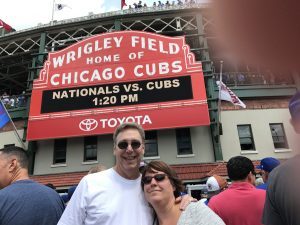 Best Baseball Moment
Best Baseball Moment
Finally seeing a game in Wrigley Field. It was truly everything I thought it would be. Like the purest form of baseball distilled into perfect form. I bonded with the woman from Wisconsin who’d driven nine hours to see a Cubs game with her family—her 30th anniversary present. I soaked in the Chicago accents of the guys in front of us who bemoaned that the beer guy wouldn’t make the trek up to our section. I cried. More than once. I cried as we were walking in. I cried when everyone cheered, like in the right places and as if they were paying attention and knew something about baseball. I cried singing, “Take Me Out to the Ball Game.” I cried when we all stood up for the dramatic last at-bat, in which Bryce Harper struck out. I felt for a few hours that everything would be okay in the end. If we could still all love baseball together, we could find our way back, eventually. I hope 2018 proves me right.
December 7, 2017
Two hundred and fifty-four plus rejections and counting later…
Looking back on the dumpster fire of a year that 2017 was in so many ways, I thought I’d try to focus on some good things that happened to me in the middle of the all-around shit-storm.
Roxane Gay had a series of tweets recently correcting people who call her an “overnight success.” If you’re someone who pays attention to the literary world, you know this is a damned lie. Roxane Gay has been working her ass off for years in the trenches. And maybe some people make it as bestselling writers without having worked their asses off for years. But I don’t know who those people are and I don’t think I’d like them much if I did. So along with a celebration of the great things that happened for me, I thought I’d include all the rejection that came in between.
In February of this year, I signed with the amazing and effervescent Brent Taylor of Triadas US Literary Agency!!! This was a pretty big deal for me because as many of you out there know, getting an agent is not an easy thing.
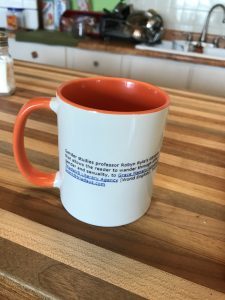
Celebrate the good things with mugs, as I learned from Leesa Cross-Smith
I sent my first query letter to an agent in May of 2013. That was for the first ever novel I wrote and in retrospect, it was not such a great novel. I mean it was okay and I actually got a few requests for the full (for you non-writers, this is when an agent asks to read the entire novel, instead of just the first few pages), as well as some very nice detailed feedback from the amazing Linda Epstein. But unless you’re some amazing writer superstar (and I don’t believe those people really exist), your first novel is probably not that great.
I queried different projects on and off for the next four years. Because I keep meticulous records, I can tell you that in total, I got rejected 54 times by agents over those four years. Those are just rejections from agents and really, that’s still a fairly small number. I also got about 200 rejections from literary journals and magazines. If you add all the contests I entered as well as the fellowships and retreats I applied for, I’m pretty sure I’d hit 300 rejections.
Depending on who you are, four years and over 300 rejections either sounds insane or like nothing at all. In retrospect, four years and 300 rejections seems fairly lightweight. While I was in the middle of it, it was interminable.
And then as things do, right when I least suspected it, everything happened at once. I’d had this weird idea for a nonfiction book about gender as a choose your own adventure bouncing around in my head for a year or so. I put the final touches on the proposal and sent it off to a couple of agents. Two weeks later, I signed with Brent, who is like a one-man crusader for making the publishing world as diverse and spectacular as it can possibly be. A couple of weeks later, we sent out the proposal. In June, I had a book deal!!!
Don’t get me wrong. Those 3-4 months between sending out the first submission to editors and getting the offer sucked in a lot of ways. I mean, it was super exciting knowing that at any moment, any day, I could get this e-mail saying someone wanted to publish my book. But there was also more rejection in there and moments when I lost faith again, even though being on submission for 3-4 months is actually pretty quick. And when I got the letter from the editor at Sourcebooks, I knew that they GOT IT. There was no need to explain to them why this book was so important and cool. They were already there.
Every single writer has a story like this behind them. And the rejection never ends. Since I signed with my agent and got the book deal, I’ve been rejected some more. The one thing that is promised to you as a writer is that you will be rejected. A lot. As many rejections as I have ahead of me, there are even more ahead. That’s how it goes.
People think writers are crazy for all kinds of reasons, but this is the real and true nature of our insanity. As a writer you get told no over and over and over again, but you’re crazy enough to just keep going. As craziness goes, it’s a fairly good kind of craziness and one that probably works in a lot of areas of life. We will fail. A lot. What then?
October 8, 2017
Madison Monday: Main Street Loft Tour
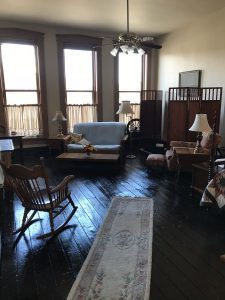
Guest quarters above Village Lights.
This was the second year for the amazing Madison Main Street Loft Tour. We didn’t get to go last year because we had obligations at Hanover’s homecoming. This year we skipped homecoming in favor of checking out some of the amazing spaces that hover above us in downtown Madison.
The loft tour is awesome regardless of where you’re coming from. For out-of-towners, hopefully there’s a chance to see some of the inspiring spaces downtown just waiting for someone to move to town and give them a little love. And for the loft spaces that have been re-furbished, you can see the possibilities–how beautiful a loft apartment that looks down on Madison’s Main Street could be.
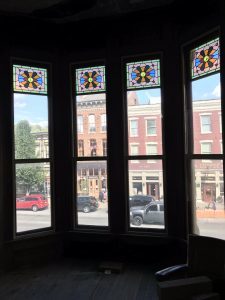
Bay windows from the building next to City Hall
For me, the cool thing about the loft tour is being able to see spaces that are both intimate and exotic. I’ve spent hours and hours staring at the two buildings that sit next to City Hall, as they’re across the street from my favorite coffee shop. I have long loved the bay window in the one building. I’ve often wondered what it looked like inside. On Saturday, I got to see those spaces at last and they did not disappoint.
Imagine what it would be like to live in an apartment here, with that bay window looking down on the coffee shop? All the action of Main Street (and there’s a lot of action) laid out for you 24 hours? It’s sort of like a writer’s dream come true, or maybe anyone who’s just really into people-watching.
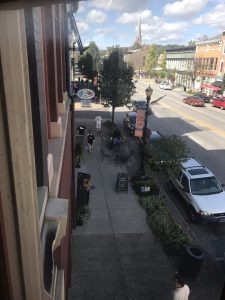
What a view!
And on the subject of writer’s dreams-come-true, there’s the re-furbished apartment space above Village Lights Bookstore. A beautiful apartment with a view of Main Street and an awesome, independent bookstore right below–it doesn’t get much better than that. These guest quarters can be used for visiting writers and artists, which makes me wish I was a writer visiting Madison.
We got to see into the bell tower of the tallest building in Madison, Trinity Methodist Church (no, we did not get to ring the bell). At the Fountain Building, which used to be Vail-Holt Funeral home, we saw these marble sinks, installed in all the rooms on the second floor. The sinks wouldn’t have been original to the house, as there wasn’t running water. They were still pretty cool.

Sinks in the Fountain Building
The highlights of the tour for us? The adorable apartment at 108 Main St. and 103 W. Fountain Alley, including a cute little, portable bar (yes, you can see what our priorities are) and a great Madison, art print. Then the view from the third floor of that buildings next to City Hall. Isn’t our town beautiful?
But the very best was the top floor of the Fountain Building. This attic will make an awesome living space. For now, it’s where two antique embalming tables still sit, pushed into a corner against the windows that look down onto the sidewalks where I walk by every day.
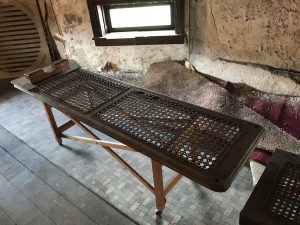
Antique embalming table
This is what the loft tour so perfectly reveals–even in a space as small and as intimate as downtown Madison, there are so many more secrets to explore. You can spend the whole of your life in a spot and never know everything about it. What a wonderful thing to remember.
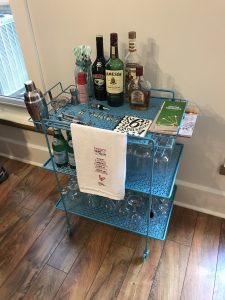
The adorable little bar.
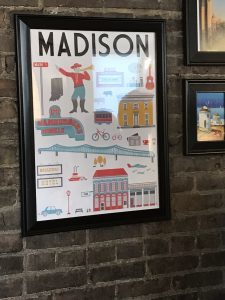
I love this print!
September 28, 2017
Star Trek: The Next Generation turns 30 and this means I am old
Star Trek: The Next Generation premiered on this day, 30 years ago. Yep, thirty years. Which means I was thirteen when I watched the first episode and that I am quite old now. Let me reflect a bit on exactly how old I am.
When Star Trek: TNG first aired, I was thirteen, but already into science fiction. I’d read Issac Asimov and Frank Herbert in paperback copies my dad brought home from the airport when he traveled. I waited for each new book in the Dune series and went to buy them at the Waldenbooks in the mall, because back then, that was the only place to buy books if you lived out in the burbs/farmland like I did. Really. The only place. No Amazon. No Barnes and Noble. Just a tiny little bookstore next to the Spencer’s and there were SO MANY books they didn’t have. But if they didn’t have them and the library didn’t have them, you were out of luck.

Yes, I still have the book and it is still awesome.
I had been reading science fiction for a while and watching Doctor Who on the local PBS station, which was channel 48. Dr. Who came on Saturday nights and my dad must have gotten me into that, too. “This is where Star Trek got all their ideas,” I remember him telling me. I fell in love with Tom Baker. I wanted to be a companion. The Waldenbooks had ONE Doctor Who book, an illustrated guide. I bought it and studied it closely. That was what fandom looked like back then. No one else to talk to. No chat rooms. No Tumblrs. Just you and the one book they had at the mall.
You COULD NOT bring the science fiction books you were reading to school with you. You COULD NOT talk about them to anyone else. You COULD NOT mention Doctor Who, not because people would think you were a geek, but mostly because no one knew what it was. When Star Trek: TNG came on, you couldn’t admit that you watched it. You couldn’t tell any of your friends that you watched it religiously. Greedily. You could not tell anyone.
I never watched the original Star Trek, though of course, I knew what it was. My cousin had an old Star Trek playset. He had a Spock doll we would play with. I don’t think we ever pretended to beam Spock up and he was too weird to make out with the Barbies.
But I was prepared for TNG because as Saladin Ahmed pointed out on Twitter, sci-fi was rare and hard to find back then. It was a big deal. At least where I grew up, there was nothing cool about liking science fiction.
So I remember the first episode of TNG. I remember being freaked about by Picard’s bald head. I remember watching it every single week. I fell hard in love with Data. I wanted to be an android, too. It would have made being a teenager so much easier. The world of TNG was one of the most important landscapes of my imagination. I made up stories to insert myself into the narrative, because that was what fanfiction looked like back then. But I still kept that all to myself.
In college, there were clearly other kids who had watched TNG, but I didn’t hang out with them. And I’d learned my lesson. It was okay to read X-MEN comic books. And in rooms with closed doors, you could talk to a few close friends about TNG. In graduate school, I ended up in an apartment all by myself and late at night, I would watch re-runs of TNG over and over again. But I didn’t talk about it.
Last week, the newest Star Trek franchise premiered. My husband and I recorded it, but we haven’t watched it yet. He watched TNG, too. It’s cool. I know it’s cool. I know that if I mention episodes of TNG when I’m teaching, no one will laugh at me. I believe that’s true, but it’s hard. A friend told me once (he watched TNG, too, and sometimes we would talk about it) that as we grow up, we don’t change so much as add layers on top. The 13-year-old is still inside there hidden under the layer of the 20s and 30s me. She’s whispering, “Don’t talk about it. Don’t!”
But here I am doing it anyway. I am old and the greatest gift of being old is running out of fucks to give. Also, that the world changes and suddenly, it’s okay to like science fiction. It might even be cool. The old cast members have millions of followers on Twitter and when I see them talking to each other, I get all warm and fuzzy inside. They are good people to have spent your adolescence with.
September 25, 2017
Monday Musings
I’ve been walking around more lately, even in the heat. Partly I’m walking to keep myself healthy. Partly I’m walking to get my sense of smell back. I read that exercise is supposed to help. I couldn’t smell anything for about three weeks this summer when I had a horrible cold. It’s come back very slowly, but it’s still not the same. It’s hard to smell things that aren’t directly in front of my nose. It’s weird to walk through the world knowing that certain scents are missing. Fresh-cut grass. Honeysuckle. I miss even the bad smells, like skunk and full garbage cans that have been sitting in the sun too long. I feel like I’m not the same person if I can’t smell like I used to.
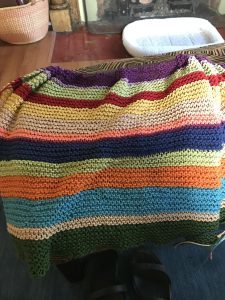 I’ve been knitting a baby blanket for a friend. I spend a lot of time deciding which colors to choose and how to line them up. There’s a pink in there I’m still not sure about. I have to make myself use pink. I can’t get over my aversion to the color which is all about everything pink is supposed to represent. I was not the kind of girl who liked pink. I am not the kind of woman who likes pink. Which is it’s own kind of stupid constraint I’ve put on myself. I don’t judge other women for liking pink. I should be able to like pink if I want to without it meaning anything about who I am. But I can’t bring myself to go there.
I’ve been knitting a baby blanket for a friend. I spend a lot of time deciding which colors to choose and how to line them up. There’s a pink in there I’m still not sure about. I have to make myself use pink. I can’t get over my aversion to the color which is all about everything pink is supposed to represent. I was not the kind of girl who liked pink. I am not the kind of woman who likes pink. Which is it’s own kind of stupid constraint I’ve put on myself. I don’t judge other women for liking pink. I should be able to like pink if I want to without it meaning anything about who I am. But I can’t bring myself to go there.
So I’m not sure about the pink. And I spend a lot of time wondering if I should put the two shades of purple next to each other. Then I wonder about the sociology of color schemes. I suspect there are social class dimensions to what colors look “right” to me. This may also be part of what makes me nervous about the pink. It’s not a pale, subdued pink. It’s a bright, almost neon type pink. It is a “trashy” pink. I shouldn’t be thinking this, either, but there it is. Our aesthetics are all wrapped up with who we are, including how much money our parents made and how long we spent going to school.
 I stole an idea from a writer friend of mine (I might have stolen the baby blanket idea from her, too, I can’t remember), Leesa Cross-Smith (she has a novel coming out in March 2018, Whiskey & Ribbons, which you should pre-order now because it will be amazing) and ordered this mug. The mug is personalized with the announcement of my book deal on the side. I have an agent and a book deal and those are two things I wanted for a very long time, so I’m trying to make myself stop and enjoy it. The book is called Gender: Create-A-Path and it teaches you all about gender and sexuality using the format from old choose-your-own-adventure books. It’s like bringing my gender classes out into the world, which I think will be a good thing. It’ll be available from Sourcebooks in Fall 2018.
I stole an idea from a writer friend of mine (I might have stolen the baby blanket idea from her, too, I can’t remember), Leesa Cross-Smith (she has a novel coming out in March 2018, Whiskey & Ribbons, which you should pre-order now because it will be amazing) and ordered this mug. The mug is personalized with the announcement of my book deal on the side. I have an agent and a book deal and those are two things I wanted for a very long time, so I’m trying to make myself stop and enjoy it. The book is called Gender: Create-A-Path and it teaches you all about gender and sexuality using the format from old choose-your-own-adventure books. It’s like bringing my gender classes out into the world, which I think will be a good thing. It’ll be available from Sourcebooks in Fall 2018.
September 11, 2017
Madison Monday: what we don’t know
When you fly into Key West, you spend a lot of time over the ocean before anything like land appears. There is water and water, and then tiny dots of green stuck in the middle. The first time I flew to Key West what struck me was how alone the island was, jutting out into the middle of a blue nothingness. I remember thinking how hard it would be to get anywhere else from here.
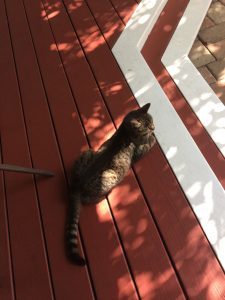
A Key West cat
Over the weekend, Hurricane Irma made a beeline for the Keys and people are saying it’s the heaviest storm to hit that area in 57 years. Because it’s a place I love, I spent a lot of time trying to find out how Key West fared. Were people okay? Was most of Old Town under water? Did any of the buildings, some of them as old as the buildings here in Madison, get damaged? Are the Hemingway cats okay?
Pretty quickly it became clear that after early Sunday morning, no one knew. No one really knew how badly Irma hit the Keys. There were rumors of a “humanitarian crisis” and the pressing need for a mobile morgue unit, but it’s unclear if that’s true or not. Even by Monday morning, places like the Miami Herald were saying, we’ll have to wait and see. Wait until the sun comes up and planes can fly into the airports again. With power and cell phone service out and roads that aren’t yet passable, we just don’t know.
How strange is that? To say in 2017 that we just don’t know what’s happening in a place, a place that is still (though sometimes not willingly) part of the United States. Our constantly updated world of Twitter and Facebook and 24 hour news just sort of ends at a certain spot on U.S. 1. Beyond that are people we hope are alright and an island we hope is still there.
September 4, 2017
Madison Monday: Labor Day Ramblings
Cool Weather
This weekend the weather turned cool for a few days and suddenly I wanted to do all the things. I got out of bed so excited on Friday. So excited about a whole day of drizzly rain. Rain and rain and rain (and not the sort like in Houston, to threaten your life and home). And cool enough to put on a sweatshirt–one with a hood, of course. And then I made a list of all the things I wanted to do in the cool weather and rain. Make soup. Bake bread. Make chicken broth. Drink an IPA (isn’t an IPA better in cool weather?). Knit. Open the windows to hear the rain.
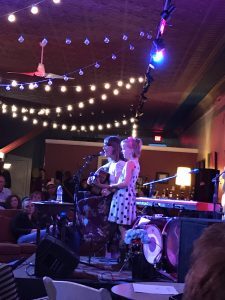
Saw this beautiful woman and her daughter at the Red Bicycle
And then, you know the way things go. In no time at all, I was feeling anxious, trying to fit everything in. Running out of time because on Monday, work starts up again for me.
That’s the way it goes. Did I enjoy my rainy day? Who knows? But that night, we had some drinks with friends and went to see some music at the Red Bicycle. And that part I remember, because then we just sat and talked. We just sat and listened. There was nothing else that needed to be fit in. There was nothing else that needed to be done.
My phone
The other day, I got out of bed after my husband and saw his phone sitting on the bedside table. Oh, I’ll take it to him, I thought. Then it occurred to me that he didn’t need it. He didn’t want it. That his morning was okay without his phone. So I’ve been trying to spend more time in rooms without my phone. I’ve been leaving it places on purpose. I’ve been trying to pick up something else when the urge hits–my knitting, a book, dirty dishes, a pen, nothing. I’m trying to recover life before my iPhone. I’m trying to spend more time in this world.



